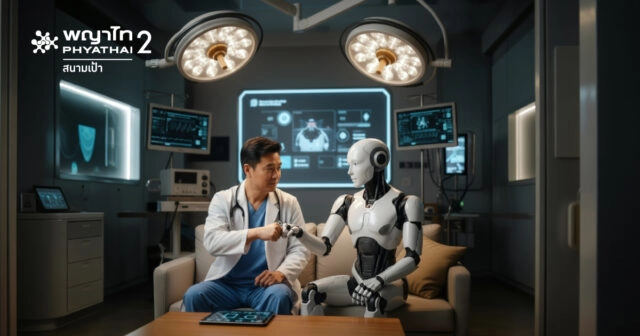Robotic Hip Surgery, Modern Precision Technology

Total Hip Arthroplasty (THA) is a crucial surgical treatment for patients suffering from chronic hip joint degeneration, pain, and walking difficulties. Navigation technology in surgery significantly improves the accuracy of hip prosthesis placement, enhancing surgical outcomes and patient safety. At Phyathai Hospital 2, advanced navigation-assisted total hip replacement is combined with expert surgeons to deliver precise, safe, and effective treatments that promote faster recovery and better long-term quality of life.
What is Navigation Technology in Surgery?
Navigation technology in surgery refers to a computer-assisted system that guides surgeons in accurately positioning orthopedic implants, such as hip prostheses, during operation. Unlike traditional methods that rely heavily on visual assessment and surgeon experience, this technology uses real-time data obtained during surgery to optimize implant placement without the need for preoperative CT scans. This approach is called "imageless navigation," which analyzes and displays the patient’s anatomical details live, improving precision and consistency in surgical results.
Key Features of Imageless Navigation Technology
Real-time Anatomical Analysis: The system measures angles like acetabular cup inclination and anteversion, leg length, and offset during surgery for tailored prosthesis placement.
3D Sensor Tracking: Infrared cameras with reflective markers track bone and instrument movements during surgery, ensuring precise alignment.
User-friendly Interface: Clear displays allow surgeons to plan and adjust implant positioning accurately throughout the procedure.
Leg Length and Hip Angle Balance: Navigation reduces discrepancies in leg length and hip alignment, minimizing postoperative complications.
Cost and Time Efficient: Eliminates the need for preoperative CT or MRI scans, reducing both cost and patient preparation time.
Superior Accuracy: Clinical research confirms that navigation-guided THA reduces positioning errors and related complications compared to traditional surgery.
Suitable Candidates for Hip Navigation System
1.Elderly patients with hip degeneration from aging or trauma.
2.Individuals with hip deformities like dysplasia or injury-related damage.
3.Patients with severe osteoarthritis affecting the hip joint.
4.Those experiencing chronic hip pain and mobility challenges.
5.Patients seeking highly accurate surgery with minimized risks.
Comparison with Robotic Arm Systems
The navigation system employed in hip arthroplasty should not be confused with robotic arm surgery systems. Navigation technology uses real-time data analysis without requiring preoperative imaging, potentially lowering costs and simplifying the surgical workflow. Although different from robotic assistance, it has proven effectiveness in improving surgical accuracy and patient outcomes.
Proven Benefits and Effectiveness
International studies validate that navigation-assisted THA significantly reduces errors in component placement, decreases the risk of complications such as leg length discrepancy and hip dislocation, and is beneficial for patients with complex hip anatomy like dysplasia or abnormal bone angles. This technology supports safer, more predictable surgeries leading to improved long-term joint function.
Phyathai Hospital 2 Orthopedic Robot Center
At Phyathai Hospital 2, the Orthopedic Robot Center utilizes cutting-edge navigation technology combined with highly experienced hip surgeons to offer state-of-the-art total hip replacement procedures. Emphasizing Value-Based Healthcare, the hospital focuses on quality treatment and enhancing patients' long-term quality of life. The dedicated medical team is trained in navigation-assisted and musculoskeletal surgeries, ensuring comprehensive care that meets international standards. Patients can rely on Phyathai Hospital 2 for safe, accurate hip surgeries that promote swift recovery and lasting mobility.


